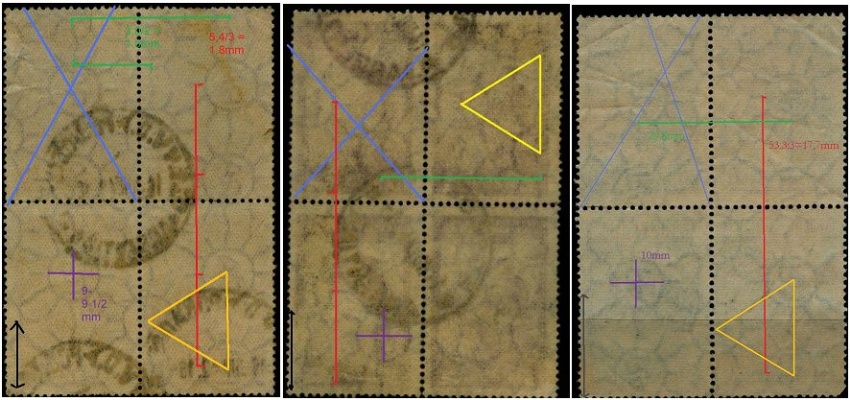P&R I Classification
Moderador: Rein
- Rein
- Usuario Colaborador

- Mensajes: 6258
- Registrado: 13 Mar 2009 15:59
- Ubicación: Leiden, Netherlands
- Contactar:
Re: P&R I Classification
The 3 PARALLEL watermarks may be basically the SAME watermark - originating from the same ENGLISH source!
The difference lies in the weave of the paper machine, with diagonals being more or less steep!
In the larger size starting from the bottom corners,
the diagonals end in the top row of perforation holes symmetrically !! => 1E1, 1E3a = MI 1
the diagonals end in the left and right sides of perforation holes at the same height => 1E3c = MI 4;
the diagonals end in the top row of perforation holes BUT Asymmetrically => 1E3b, 1L1 = MI 5
The difference lies in the weave of the paper machine, with diagonals being more or less steep!
In the larger size starting from the bottom corners,
the diagonals end in the top row of perforation holes symmetrically !! => 1E1, 1E3a = MI 1
the diagonals end in the left and right sides of perforation holes at the same height => 1E3c = MI 4;
the diagonals end in the top row of perforation holes BUT Asymmetrically => 1E3b, 1L1 = MI 5
- Rein
- Usuario Colaborador

- Mensajes: 6258
- Registrado: 13 Mar 2009 15:59
- Ubicación: Leiden, Netherlands
- Contactar:
Re: P&R I Classification
The parallel watermarks always have the direction of paper parallel to the long side of the stamp with TWO exceptions:
MI 1 of the 25c and the 2pesos!
How is this possible??????
In the mid-1930ies we have 3 types of stamp sizes:
- the small sized JSM stamps
- the medium sized PyR I stamps
- the larger sized PyR I stamps
I will not take into account the Airmail stamps for the time being!

Two sheets have the same size, the other is similar but different!
We can expect rthe 25c and 2pesos stamps to have been printed on the paper of the medium sized stamps. Not by mistake, in the sense that a sheet got accidentally misplaced, but used for a particular printing!

MI 1 of the 25c and the 2pesos!
How is this possible??????
In the mid-1930ies we have 3 types of stamp sizes:
- the small sized JSM stamps
- the medium sized PyR I stamps
- the larger sized PyR I stamps
I will not take into account the Airmail stamps for the time being!

Two sheets have the same size, the other is similar but different!
We can expect rthe 25c and 2pesos stamps to have been printed on the paper of the medium sized stamps. Not by mistake, in the sense that a sheet got accidentally misplaced, but used for a particular printing!

- Rein
- Usuario Colaborador

- Mensajes: 6258
- Registrado: 13 Mar 2009 15:59
- Ubicación: Leiden, Netherlands
- Contactar:
Re: P&R I Classification
The small sized JSM stamps had the orthogonal watermarks for quite some time in the 1930-ies!
When was the last one on paper with a parallel watermark???? in 1930???
As to the Airmail stamps, they had been printed in sheets of 5x10 i.e. half of the larger sized ones => 25x45cm.
rc2260
When was the last one on paper with a parallel watermark???? in 1930???
As to the Airmail stamps, they had been printed in sheets of 5x10 i.e. half of the larger sized ones => 25x45cm.
rc2260
- Rein
- Usuario Colaborador

- Mensajes: 6258
- Registrado: 13 Mar 2009 15:59
- Ubicación: Leiden, Netherlands
- Contactar:
Re: P&R I Classification
José,Otin » Today 01:31 escribió:
Tony:
Mi mensaje anterior lo escribí desde el negocio de un comerciante filatelíco que no me creía lo del 2p RR difusos. Las fotos son más que elocuentes y me gustaría saber la fecha del cuadro usado de este papel. Cuando ubiqué sus fotos lo llamé a Pettigiani ( va a sacar un libro también sobre PyR I) para que viera ese portento que Ud. se da el lujo de tnerlo nuevo y usado.
Mi pregunta por las diferencias de estructuras del papel que dice Rein existen, me gustaría que me las explicara Ud. En efecto, no le endiento cuando habla de tramas asimétricas, etc. etc. porque con sellos de los dos papeles en ese momento (teníamos el stock del comerciante a nuestra disposición) comprobamos que las medidas del difuso y el nítido son idénticas, lo que nos hace
pensar de que se trata del mismo bailarín, pero con distinta calidad de fibras y talvez, como dice Rein, la malla de la Fourdrinier haya sido cambiada. Hay que recordar que el RR difuso apareció por 1942 y el nítido por 1947. Observo una cosa: el
papel del nítido es el mismo que se usó para imprimir el sello Nº MT 499 salvo que éste tenía filigrana Casa de Moneda. Según me m
anifestaron los importadores de ese papel, sería de procedencia italiana.
Espero sus noticias. Merlo
PD. Cómo funciona el hilo me lo explicarán y lo aplicare as soon as possible.
the dandy-roll can still be the same while the paper machine's weave has got changed! That is what I suggest with the 3 parallel watermarks of English origin that could have 3 different paper meshes - MI 1, MI 4 and MI 5 !
The 2 Rayos Rectos can both have the same dandy-roll, but different paper meshes [although the difference in time is remarkable] and the 1948 17 October stamp has the same flocculous paper feel as the Rayos Rectos Nitidos [same paper machine] but with a different dandy-roll! The feel is obviously the same at that of the RRN! As you suggest - Italian - Cartiere Pietro Miliani SpA (Italia)
- Rein
- Usuario Colaborador

- Mensajes: 6258
- Registrado: 13 Mar 2009 15:59
- Ubicación: Leiden, Netherlands
- Contactar:
Re: P&R I Classification
Rein escribió:The small sized JSM stamps had the orthogonal watermarks for quite some time in the 1930-ies!
When was the last one on paper with a parallel watermark???? in 1930???
As to the Airmail stamps, they had been printed in sheets of 5x10 i.e. half of the larger sized ones => 25x45cm.
rc2260
According to José Merlo in his 1966 publication, paper nr 29 was new in 1935/1936, so it could not have anything to do with the JSM papers!
The papers for the medium sized and the larger sized must have kept separately in the Casa de Moneda because of their slightly different size of the complete printing sheets.
- Rein
- Usuario Colaborador

- Mensajes: 6258
- Registrado: 13 Mar 2009 15:59
- Ubicación: Leiden, Netherlands
- Contactar:
Re: P&R I Classification
José Merlo in his 2008 publication (Revista 2250 on the paper nr 13

first states that the number 27 had been used for reel-fed typography and the nrs 13 and 29 for sheet-fed offset-litho.
Knowing the counter sheet sizes of either 20x10 [small and medium size] or 10x10 [larger size] and 5x10 [larger size Airmail] it is strange to read about (printing) sheets of 400 (no 29) or 200 (no 13)!

The reels of nr 27 had a width of 28cm! Cut off in loose sheets with a height of 50cm which is much higher that necessary and the found height of the top margins [5-10mm] does suggest.

10x26.0= 26cm will allow not even a full width stamp for both left and right margins, 10x37.5=37,5cm will leave 12.5cm ≈ 3.5 stamp for top and bottom margin .
Both no 13 AND 27 have an orthogonal watermark! What is the printing sheet size of no 13???? 56x50cm - not likely to have 28x100!
And no 29??? 50x70cm??? Double sheet for the medium sized PyR I ????
To make it even more complicated!
Have look at the complete sheet of the typographed ministerial in Göttig-Jalil on page 409!
Calculating the size of the sheet [75% reduction in the catalogue] we get 25x28cm! Was the sheet size for no 27 50x28cm instead of 28x50cm??? And could we have had a double width reel of the typography stamps!?!?!?
It is about time to come up with the known or observed facts as to the sizes of the counter sheets and the printing sheets and how the counter sheets are positioned within a printing sheet!
to be continued ....
rc2263

first states that the number 27 had been used for reel-fed typography and the nrs 13 and 29 for sheet-fed offset-litho.
Knowing the counter sheet sizes of either 20x10 [small and medium size] or 10x10 [larger size] and 5x10 [larger size Airmail] it is strange to read about (printing) sheets of 400 (no 29) or 200 (no 13)!

The reels of nr 27 had a width of 28cm! Cut off in loose sheets with a height of 50cm which is much higher that necessary and the found height of the top margins [5-10mm] does suggest.

10x26.0= 26cm will allow not even a full width stamp for both left and right margins, 10x37.5=37,5cm will leave 12.5cm ≈ 3.5 stamp for top and bottom margin .
Both no 13 AND 27 have an orthogonal watermark! What is the printing sheet size of no 13???? 56x50cm - not likely to have 28x100!
And no 29??? 50x70cm??? Double sheet for the medium sized PyR I ????
To make it even more complicated!
Have look at the complete sheet of the typographed ministerial in Göttig-Jalil on page 409!
Calculating the size of the sheet [75% reduction in the catalogue] we get 25x28cm! Was the sheet size for no 27 50x28cm instead of 28x50cm??? And could we have had a double width reel of the typography stamps!?!?!?
It is about time to come up with the known or observed facts as to the sizes of the counter sheets and the printing sheets and how the counter sheets are positioned within a printing sheet!
to be continued ....
rc2263
- Rein
- Usuario Colaborador

- Mensajes: 6258
- Registrado: 13 Mar 2009 15:59
- Ubicación: Leiden, Netherlands
- Contactar:
Re: P&R I Classification
So far, the uncoated parallel watermarks. The coated ones I keep for later on!
The orthogonal watermarks started already in the 1920-ies but according to José Merlo in his 1966 publication, the Austrian paper introduced in 1937 for the larger sized PyR I had no predecessors apart from an incidental Airmail stamp.

How come it got only used for the larger sized stamps and NOT for the medium sized ones????

The sheet sizes seem more or less the same! And taking into account the direction of paper [blue arrows]!
Still more difficult to explain - unless as I suggested in the previous postings, the printing sheet size is completely different! - are the 2 values that have the direction of paper turned 90 degrees!
The 25c Labrador and the 50c Petroleo!
The orthogonal watermarks started already in the 1920-ies but according to José Merlo in his 1966 publication, the Austrian paper introduced in 1937 for the larger sized PyR I had no predecessors apart from an incidental Airmail stamp.

How come it got only used for the larger sized stamps and NOT for the medium sized ones????

The sheet sizes seem more or less the same! And taking into account the direction of paper [blue arrows]!
Still more difficult to explain - unless as I suggested in the previous postings, the printing sheet size is completely different! - are the 2 values that have the direction of paper turned 90 degrees!
The 25c Labrador and the 50c Petroleo!
- Rein
- Usuario Colaborador

- Mensajes: 6258
- Registrado: 13 Mar 2009 15:59
- Ubicación: Leiden, Netherlands
- Contactar:
Re: P&R I Classification
We have 4 orthogonal watermarks with a symmetrical paper mesh [without coating]:
- 1937 Austriaco = MI 2
- 1939? Holandés = MI 3
- 1940 Mate lustroso = MI 7
- 1942 Rayos rectos difusos = RR 1
How to tell the differences???????
All have the direction of paper parallel to the long side of the stamp BUt for the 2 values in Austriaco mentioned above AND practically all of the medium sized stamp on Holandés......
to be continued .....
- 1937 Austriaco = MI 2
- 1939? Holandés = MI 3
- 1940 Mate lustroso = MI 7
- 1942 Rayos rectos difusos = RR 1
How to tell the differences???????
All have the direction of paper parallel to the long side of the stamp BUt for the 2 values in Austriaco mentioned above AND practically all of the medium sized stamp on Holandés......
to be continued .....
- Rein
- Usuario Colaborador

- Mensajes: 6258
- Registrado: 13 Mar 2009 15:59
- Ubicación: Leiden, Netherlands
- Contactar:
Re: P&R I Classification
The differences between symmetrical and asymmetrical paper mesh:
Up to the 1970-ies there were two major weaving techniques that would be found reflected in the paper wire (mesh) that forms the background of our watermarks!
The warp is the vertcal thread in the loom, the weft is the filling yarn that will be fed through the warp threads from left to right, right to left, etc.
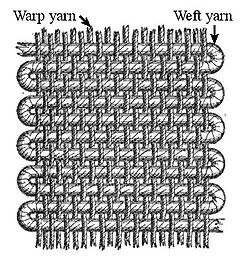
From the very beginning of the machine-made paper "plain weave" had been used. This continued into the 1970-ies, but most of the paper manufacturers had been changing to the more flexible twill weave and certainly with the availability of plastic fibres twill weave became dominant and later on even more complex weaving patterns were introduced.
The twill weave we will find only from 1938 onwards. In Argentinean postage stamps this is to be found in what is called "papel rayado" since 1951 [or maybe bit earlier?]. The twill weave is a-symmetrical hence my use of the term "a-symmetrical paper wire".
Plain weave is symmetrical and as the vertical threads are usually more dense [30/cm horizontally] than the horizontal threads [20/cm vertically] we see a stretched rhomboid in the vertical direction. This the so-called "granulado"!!!
When the vertical threads are not so densily planted, let's say 24/cm horizontally or a bit less, we get to see what was called here "Tela"
"Plain weave is the simplest type of weave. A single weft is progressively passed over one warp and under the next warp, working across the width of the loom. The weft is then passed back through warps in the opposite direction alternating from the previous over-and-under pattern. Variations are possible by using double or tripled warp or weft threads in a variety of combinations."
"Warp-faced weave fabric has greater number of warp threads per centimeter, while weft-faced weave fabric has a greater number of weft threads per centimeter. When both the warp and weft threads are equal in number per centimeter, it is termed balanced weave. All textiles fall into one of these categories."
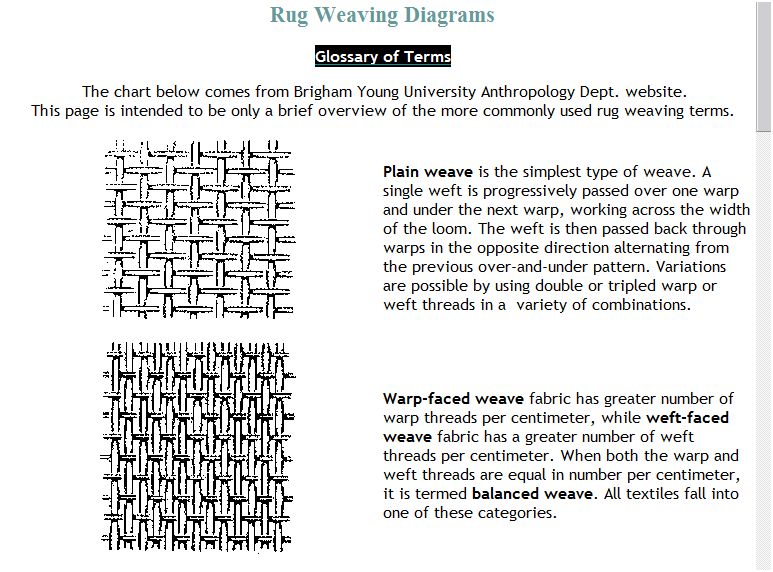
and the "granulado":
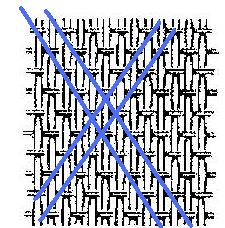
"Twill weave is similar to plain weave in that the weft passes over and under warp threads. However, warp yarns are skipped at predetermined intervals to create a diagonal rib in the weave."
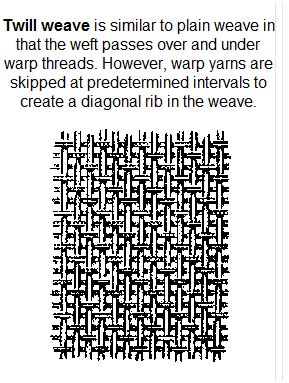
and the "rayado":
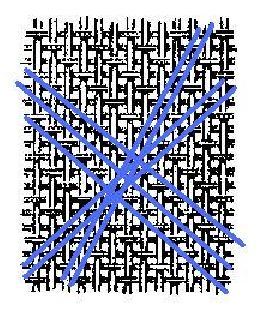 [
[
Up to the 1970-ies there were two major weaving techniques that would be found reflected in the paper wire (mesh) that forms the background of our watermarks!
The warp is the vertcal thread in the loom, the weft is the filling yarn that will be fed through the warp threads from left to right, right to left, etc.

From the very beginning of the machine-made paper "plain weave" had been used. This continued into the 1970-ies, but most of the paper manufacturers had been changing to the more flexible twill weave and certainly with the availability of plastic fibres twill weave became dominant and later on even more complex weaving patterns were introduced.
The twill weave we will find only from 1938 onwards. In Argentinean postage stamps this is to be found in what is called "papel rayado" since 1951 [or maybe bit earlier?]. The twill weave is a-symmetrical hence my use of the term "a-symmetrical paper wire".
Plain weave is symmetrical and as the vertical threads are usually more dense [30/cm horizontally] than the horizontal threads [20/cm vertically] we see a stretched rhomboid in the vertical direction. This the so-called "granulado"!!!
When the vertical threads are not so densily planted, let's say 24/cm horizontally or a bit less, we get to see what was called here "Tela"
"Plain weave is the simplest type of weave. A single weft is progressively passed over one warp and under the next warp, working across the width of the loom. The weft is then passed back through warps in the opposite direction alternating from the previous over-and-under pattern. Variations are possible by using double or tripled warp or weft threads in a variety of combinations."
"Warp-faced weave fabric has greater number of warp threads per centimeter, while weft-faced weave fabric has a greater number of weft threads per centimeter. When both the warp and weft threads are equal in number per centimeter, it is termed balanced weave. All textiles fall into one of these categories."

and the "granulado":

"Twill weave is similar to plain weave in that the weft passes over and under warp threads. However, warp yarns are skipped at predetermined intervals to create a diagonal rib in the weave."

and the "rayado":
 [
[- Rein
- Usuario Colaborador

- Mensajes: 6258
- Registrado: 13 Mar 2009 15:59
- Ubicación: Leiden, Netherlands
- Contactar:
Re: P&R I Classification
How to recognize the rayos rectos difusos is one of the problems I mentioned yesterday. Some time ago I started a thread dedicated to that type of paper. Making the scans it turns out that the watermark is not that difuse at all. But how to distinguish it from the other orthogonal watermarks!?Rubiera escribió: Sr Merlo:
No estoy completamente seguro de que verdaderamente tengo el 2p RR difusos pero si tengo este y el 1p en bloques que verdaderamente parecen serlo. Lo que debemos encontrar es estos sellos son cancelaciones anteriores a 1945 y no las he visto....seguire buscando. El problema con este papel es que es muy oscuro y tiene una filigrana, bueno, como lo dice el nombre, difusa. El 1/2c RR difuso es casi imposible de clasificar.
saludos
tony
- Rein
- Usuario Colaborador

- Mensajes: 6258
- Registrado: 13 Mar 2009 15:59
- Ubicación: Leiden, Netherlands
- Contactar:
Re: P&R I Classification
Most of this thread had been dedicated to the commemoratives:
viewtopic.php?f=2&t=2212
but also the definitives that are all in the PyR I series:
1/2c M. Belgrano
3c José de San Martin grey
12c B. Mitré in vermillion
15c M. Güemes
35c Post Office Telegrafos [already shown above]
and the
20c Toro grande
all stamps - the commemoratives included - have the medium size, all except for the 35c in portrait shape....
As I have said earlier - apart from the orthogonal aspect - the most important thing is the symmetrical paper wire. and that brings us in problems! As the so-called Austriaco also has those aspects!
Fortunately "Austriaco" does not occur in the medium sized stamps. Austriaco have the larger sized face values involved, but do not include the 20c Toro grande!
But does that guarantee us that the Rayos rectos Difusos does not occur in the other larger sized stamps???
We saw above a posting in which the existence of the 2 pesos Frutas was suspected!?
viewtopic.php?f=2&t=2212
but also the definitives that are all in the PyR I series:
1/2c M. Belgrano
3c José de San Martin grey
12c B. Mitré in vermillion
15c M. Güemes
35c Post Office Telegrafos [already shown above]
and the
20c Toro grande
all stamps - the commemoratives included - have the medium size, all except for the 35c in portrait shape....
As I have said earlier - apart from the orthogonal aspect - the most important thing is the symmetrical paper wire. and that brings us in problems! As the so-called Austriaco also has those aspects!
Fortunately "Austriaco" does not occur in the medium sized stamps. Austriaco have the larger sized face values involved, but do not include the 20c Toro grande!
But does that guarantee us that the Rayos rectos Difusos does not occur in the other larger sized stamps???
We saw above a posting in which the existence of the 2 pesos Frutas was suspected!?
- Rein
- Usuario Colaborador

- Mensajes: 6258
- Registrado: 13 Mar 2009 15:59
- Ubicación: Leiden, Netherlands
- Contactar:
Re: P&R I Classification
The 3c José de San Martin grey:
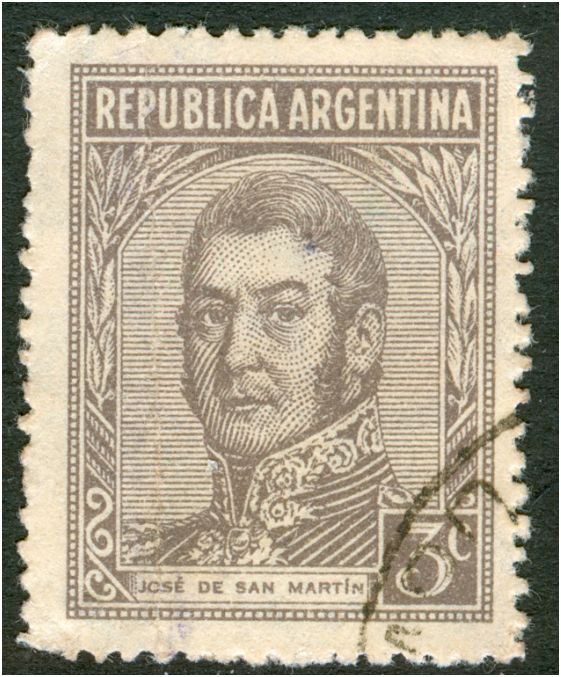
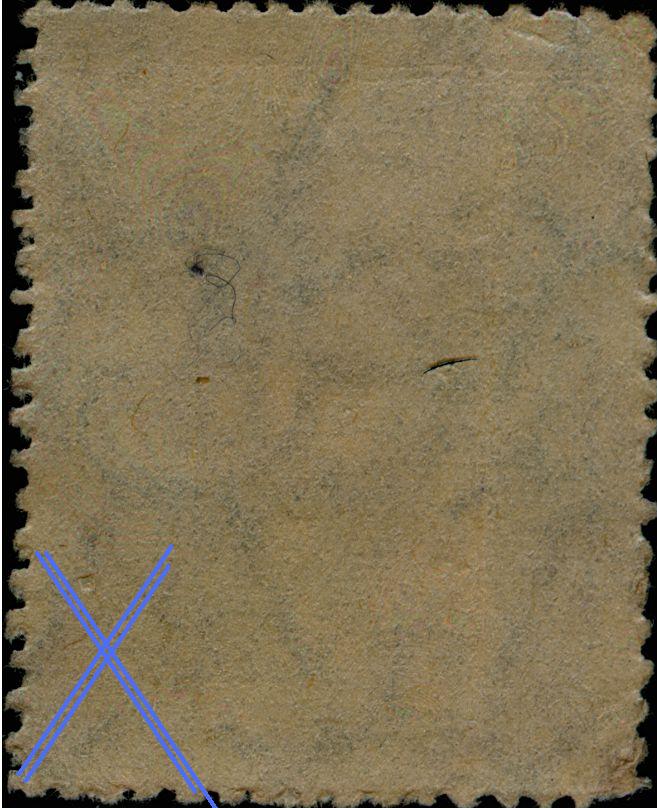
as said the symmetrical mesh is crucial!


as said the symmetrical mesh is crucial!
- Rein
- Usuario Colaborador

- Mensajes: 6258
- Registrado: 13 Mar 2009 15:59
- Ubicación: Leiden, Netherlands
- Contactar:
Re: P&R I Classification
The 12c B. Mitré in vermillion red:
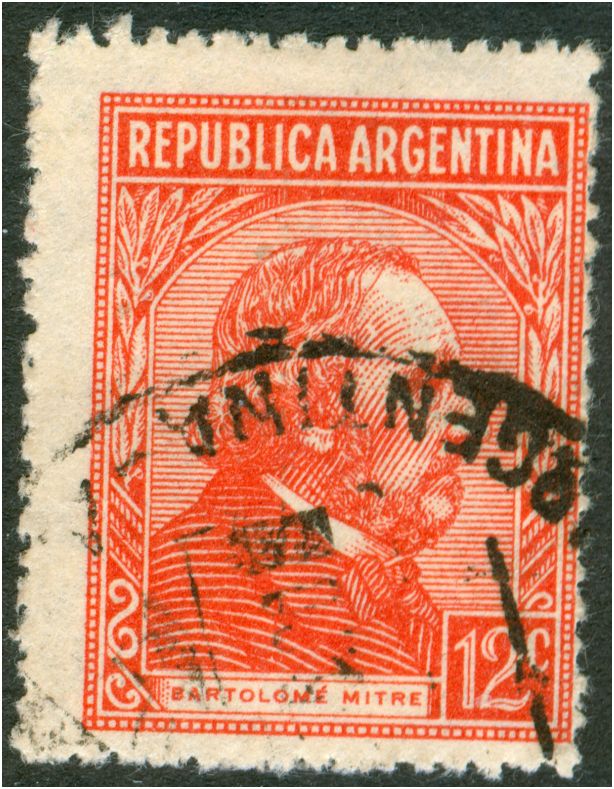
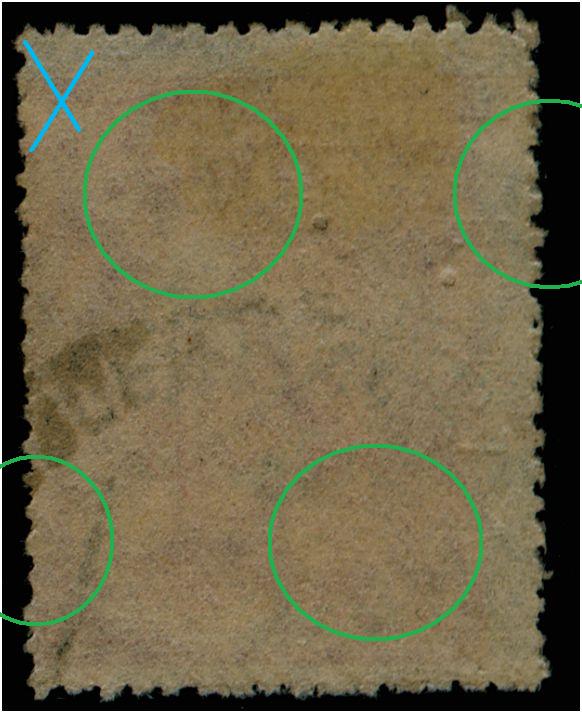


- Rein
- Usuario Colaborador

- Mensajes: 6258
- Registrado: 13 Mar 2009 15:59
- Ubicación: Leiden, Netherlands
- Contactar:
Re: P&R I Classification
The 1/2c Manuel Belgrano:
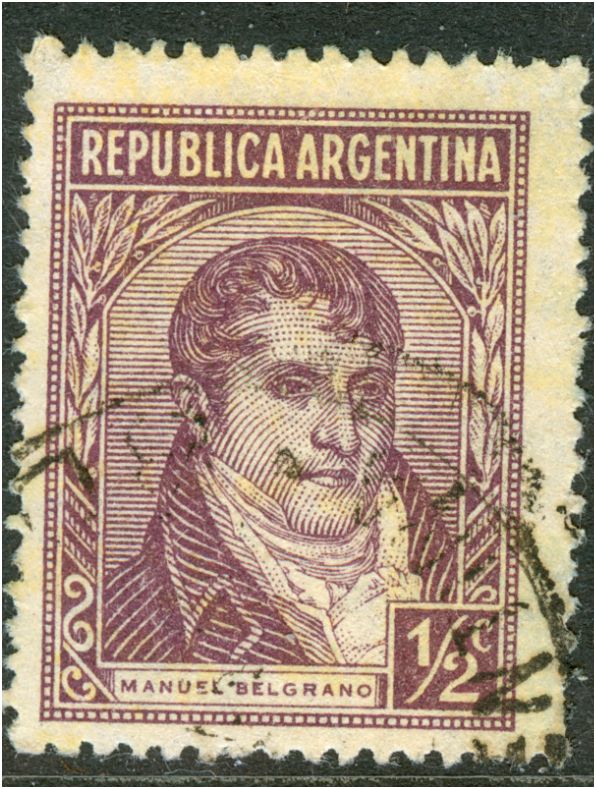
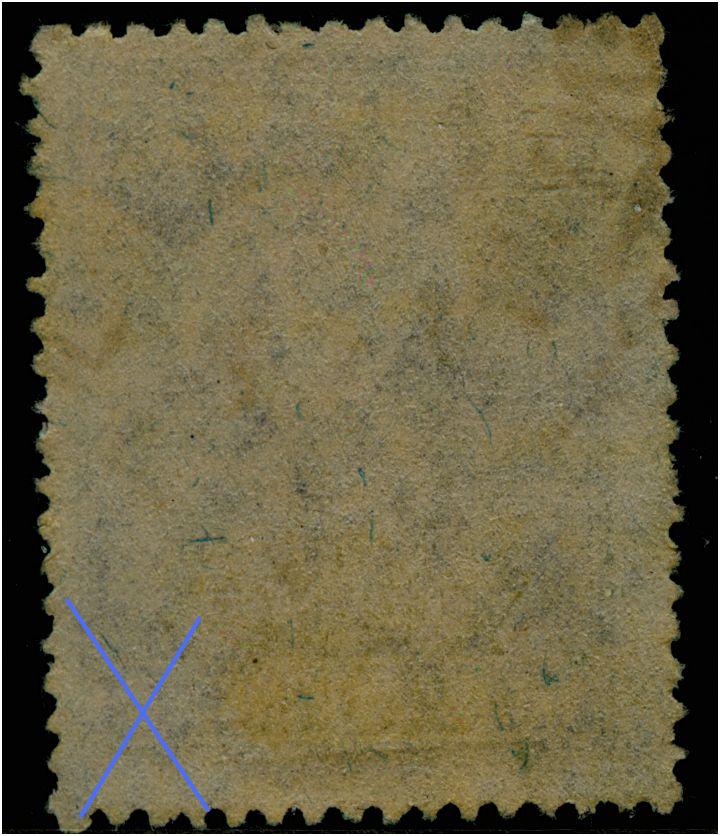
with green fibres and without:
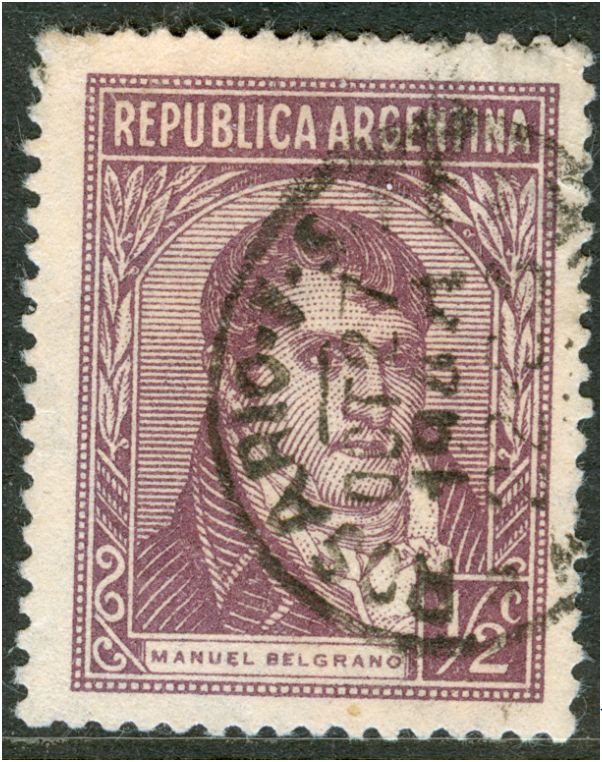
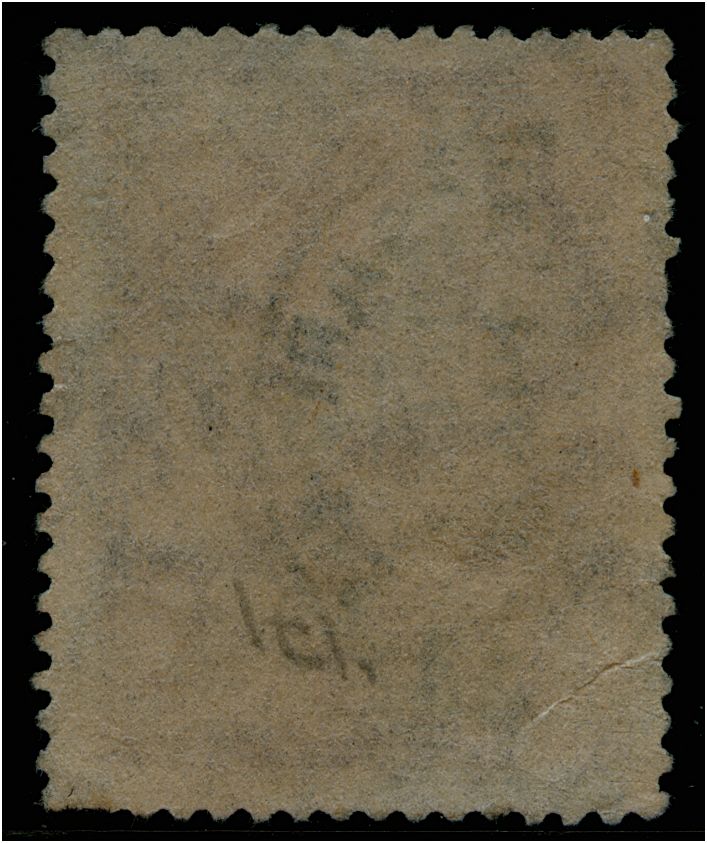
rc2292


with green fibres and without:


rc2292
